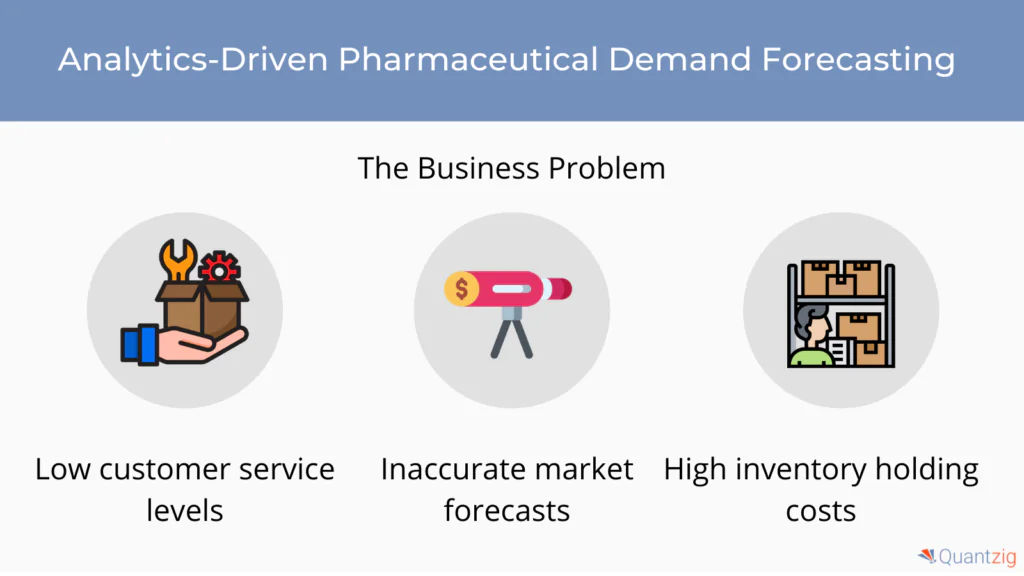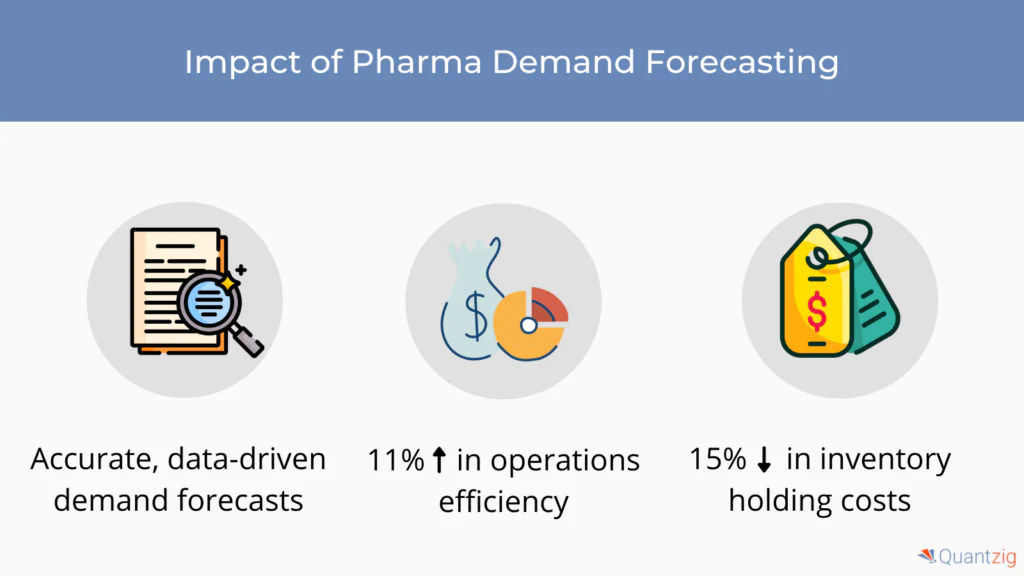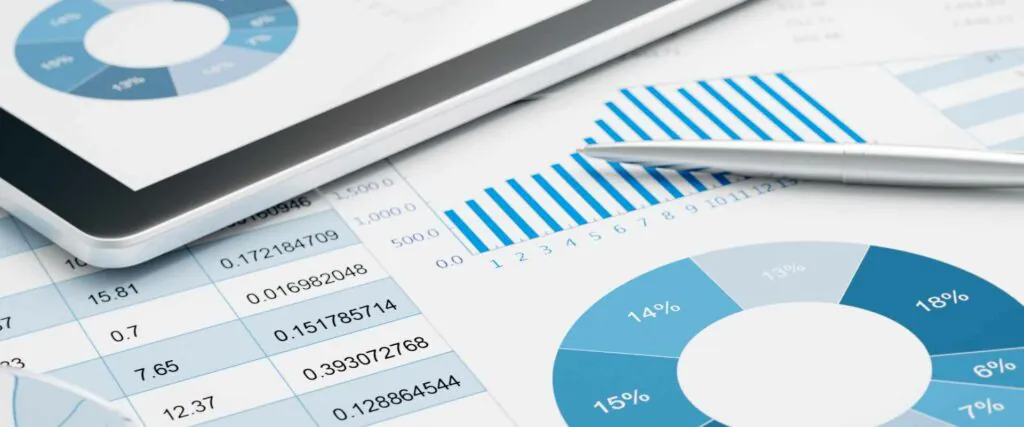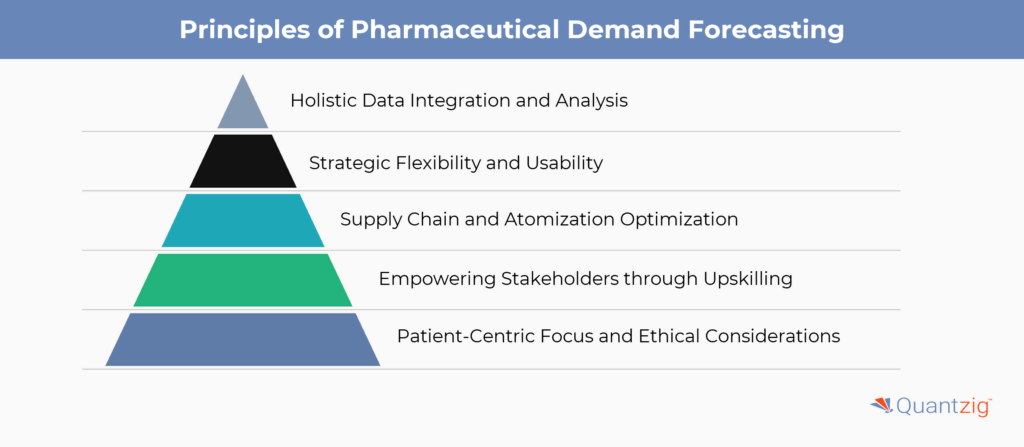Written By: Sudeshna Ghosh
Table of Contents
Introduction to Pharmaceutical Demand Forecasting
As pharmaceutical companies grapple with an abundance of data and diverse stakeholders, the forecasting approach becomes an intellectual process, necessitating upskilling and continuous training to optimize operations. This complex process involves atomization through advanced technologies like Artificial Intelligence (AI), modular platforms, and cloud-based solutions, fostering flexibility and usability.
The integration of these innovations addresses forecasting challenges such as pricing pressure, generic substitution, and the introduction of innovative compounds, ultimately contributing to the efficiency of operational and strategic decision-making. This article sheds light on the critical elements of pharmaceutical demand forecasting, emphasizing technology adoption, enterprise solutions, and the multifaceted strategies required to instill confidence in investment decisions amidst market complexity and innovation.
Book a demo to experience the meaningful insights we derive from data through our analytical tools and platform capabilities. Schedule a demo today!
Request a Free DemoQuantzig’s Expertise in Pharmaceutical Demand Forecasting for a Research-based Biopharmaceutical Company
| Category | Details |
|---|---|
| Client Details | A research-based biopharmaceutical company headquartered in the USA. |
| Challenges Faced by The Client | To devise reliable market forecasts and enhance customer service levels. |
| Solutions Offered by Quantzig | Quantzig developed a five-step pharmaceutical demand forecasting plan that include: Step 1 – Defining the Market Step 2 – Dividing Demand into Component Step 3 – Forecasting Demand Drivers Step 4 – Conducting Sensitivity Analysis Step 5 – Creation of the Demand Forecast |
| Impact Delivered | Accurate, data-driven demand forecasts that reduced product lead times, 11% increase in operational efficiency, and 15% reduction in inventory holding costs |
The Client Details
The client is a research-based biopharmaceutical company headquartered in the USA. The client’s main focus is the discovery, development, and commercialization of innovative medicines. Aiming to eliminate some of the world’s most challenging health problems and enable mass access to medicines, the client is also working with organizations across the world to eliminate healthcare inequities while continuing their exhaustive drug R&D.
How the Client Found Quantzig
The client contacted Quantzig after attending a webinar conducted by Quantzig’s analytics experts on the optimization of the end-to-end supply value chain with supply chain analytics.
The Pharmaceutical Demand Forecasting Challenge Faced by the Client

The client, a leading pharmaceutical industry client, wanted to seek ways to devise reliable market forecasts and enhance customer service levels. As a result, they wanted to predict and forecast the demand for healthcare products accurately and match the supply to demand. They also wanted to ensure that the goods are produced at the right time and delivered seamlessly to reduce inventory holding costs and inconsistencies in the supply chain.
Pharmaceutical Demand Forecasting Solution Offered by Quantzig
Accurate pharmaceutical demand forecasting is difficult in the best circumstances. Swift changes in customer demand, as being caused by the global pandemic, make it challenging. The experts at Quantzig first analyzed the existing data, basis which market forecasts were made. They then created a five-step pharmaceutical demand forecasting plan:
Step 1 – Defining the Market
Quantzig’s supply chain analytics experts defined the total market of the client’s products that included all potential end-users, competitors, and probable substitute products.
Step 2 – Dividing Demand into Component
The experts then divided the total product demand into its main components for conducting individual analysis.
Step 3 – Forecasting Demand Drivers
The drivers of demand for each component category were then understood. After listing the factors influencing the component/category demand, Quantzig’s experts made use of regression models and statistical techniques to come up with accurate demand forecasts for each of them.
Step 4 – Conducting Sensitivity Analysis
The experts then conducted a sensitivity analysis to understand the impact of various demand drivers on each forecast by varying assumptions and quantifying their impact on demand.
Step 5 – Creation of the Demand Forecast
Once the impact and importance of all demand drivers became known, the experts then created the combined, data-driven demand forecast for the client’s products.
Impact Delivered from Pharmaceutical Demand Forecasting

As a result of this engagement, the client was able to achieve –
- Accurate, data-driven demand forecasts that reduced product lead times
- 11% increase in operational efficiency
- 15% reduction in inventory holding costs
Get started with your complimentary trial today and delve into our platform without any obligations. Explore our wide range of customized, consumption driven analytical solutions services built across the analytical maturity levels.
Start your Free Trial TodayWhy is Demand Forecasting Needed in the Pharmaceutical Industry

Typically, the pharmaceutical industry comprises businesses involved in the research, development, manufacturing, and distribution of drugs. The drugs offered by these pharmaceutical industry firms play a fundamental role in improving health, preventing health complications, and increasing the lifespan of individuals. The pharmaceutical industry also includes biologically-derived, over-the-counter (OTC), prescription-based products. Although the pharmaceutical industry is capital intensive and highly regulated, the industry is witnessing a high demand for innovations that would help reduce life-threatening conditions and diseases and further revolutionize patient treatment patterns in the coming years. Additionally, the increase in the number of middle-class populations in both developed and emerging countries and higher disposable income and expectation of better healthcare solutions are driving the growth of the industry.
However, recent studies indicate that several factors are expected to influence the growth prospects of the pharmaceutical industry over the next couple of years. These factors include:
- Impact of globalization: Adhering to government regulations around taxation, trade, approvals, market access, and pricing continues to be a struggle for firms within the pharmaceutical industry space.
- Strict government regulations: The compliance requirements vary according to the countries, and firms are expected to ensure that these protocols are met before launching the products into the market. These variations in the compliance regulations are expected to pose problems for firms looking to invest in product innovations.
These factors are compelling pharmaceutical industry players to leverage the use of demand forecasting solutions. Demand forecasting solutions help firms identify the types of products and the quantity to be purchased. These solutions also assist companies in streamlining and optimizing supply chain management activities.
Principles of Pharmaceutical Demand Forecasting:

1. Holistic Data Integration and Analysis:
Pharmaceutical forecasting demands a comprehensive approach to data integration, encompassing a multitude of variables such as sales data, disease modeling, and patient-based insights. By amalgamating information from diverse sources, including digitalized platforms and cloud-based solutions, stakeholders can develop a more nuanced understanding of market dynamics. This principle emphasizes the importance of adopting cutting-edge technology, including Artificial Intelligence (AI), to process vast datasets efficiently. In doing so, forecasting becomes an intellectual process, unlocking the causality behind market changes and facilitating evidence-based decision-making.
2. Strategic Flexibility and Usability:
Flexibility is pivotal in adapting to the rapidly evolving pharmaceutical landscape. A modular platform that accommodates changes in business areas, such as pricing pressures, generic substitutions, and the introduction of innovative compounds, ensures adaptability. Usability is equally critical for stakeholders to effectively navigate forecasting challenges. Implementing enterprise solutions with Power BI reporting functionality fosters transparency and enables both strategic and operational decision-making, enhancing the confidence of pharmaceutical investment decisions.
3. Supply Chain and Atomization Optimization:
To mitigate challenges faced by pharmaceutical companies related to forecasting lead times and forecasting horizon, a focus on supply chain modeling is imperative. Atomization, through the automation of processes, not only ensures efficiency but also minimizes the estimate of error in short-term and long-term forecasts. Embracing technology-driven project management capabilities and advanced analytics facilitates the optimization of forecasting practices, leading to more accurate projections.
4. Empowering Stakeholders through Upskilling:
Recognizing that forecasting is an intellectual endeavor, investing in upskilling is essential. Interactive training sessions, particularly in AI integration, equip stakeholders with the necessary skills to navigate the complexities of pharmaceutical forecasting. This principle underscores the importance of continuous learning and highlights the role of confidence in pharmaceutical investment decisions. Training in forecasting should be an ongoing process, ensuring that stakeholders stay abreast of the latest innovations and market shaping factors.
5. Patient-Centric Focus and Ethical Considerations:
In the pharmaceutical industry, forecasting should extend beyond financial metrics to a patient-based approach. Stakeholders must prioritize market shaping that aligns with ethical standards and contributes positively to the healthcare system. This principle emphasizes the responsibility of pharmaceutical companies to consider the societal impact of their decisions, promoting innovation in areas that address unmet medical needs. Confidence in pharmaceutical investment decisions is bolstered when companies demonstrate a commitment to social responsibility and ethical business practices.
Why Choose Quantzig’s Pharmaceutical Demand Forecasting Solutions?
Quantzig is the world’s foremost full-service advanced analytics and business intelligence solution provider, turning clients’ complex, unstructured data into intelligent, actionable insights that enable them to solve complex business problems and inspire innovation, change, and growth. Over the past 16 years, our insights have helped over 120 clients spanning across industries and sectors like Pharmaceutical and Life Sciences, Retail and CPG, Food and Beverage, and more. We have successfully delivered 1500 in-depth solutions in areas like Marketing Analytics, Customer Analytics, Supply Chain Analytics, and more.
At Quantzig, we firmly believe that the competencies to harness maximum insights from the influx of continuous information around us will drive any organization’s competitive eagerness and success. Our objective is to bring together the best combination of analysts and consultants to complement food and beverage organizations with a shared need to discover and build those capabilities and drive continuous business excellence through advanced supply chain analytics.
Experience the advantages firsthand by testing a customized complimentary pilot designed to address your specific requirements. Pilot studies are non-committal in nature.
Request a Free PilotConclusion
Effective pharmaceutical demand forecasting is crucial for maintaining efficient supply chains. Utilizing historical data and forecasted data, companies can enhance sales forecasting and inventory management. Trend-based forecasting models allow businesses to predict in-market product demand accurately, informing purchase order generation and strategic business decisions. Leveraging data from various market sources and Demand Solutions ensures a robust approach to understanding market dynamics. This comprehensive method is essential in the pharmaceutical industry to meet patient needs and optimize resource allocation.



